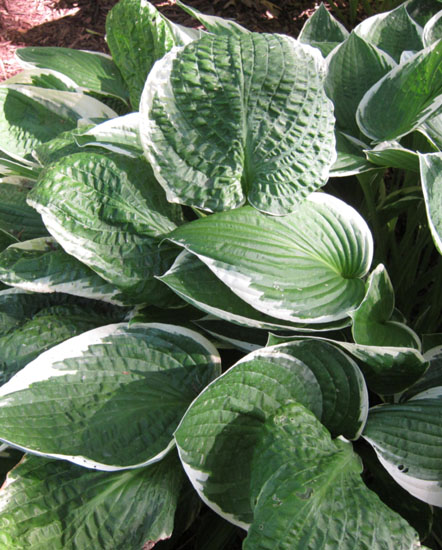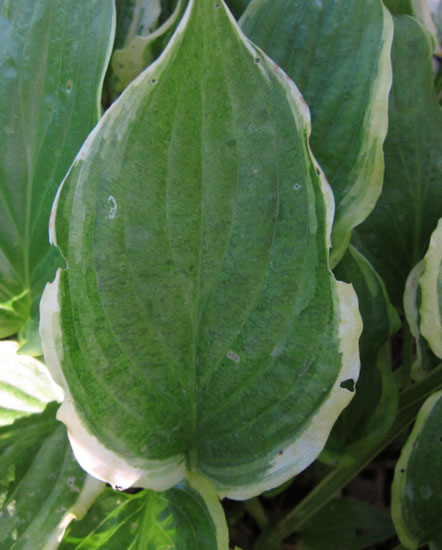Issue 6, May 29, 2012
Hosta Virus X
Hosta virus X (HVX) is a pathogen that has plagued gardeners worldwide. As with most viruses, HVX will not kill hosta; however it can cause a number of undesirable symptoms to appear on the host. HVX is also a difficult virus to pin down because symptoms can often take years to appear in infected hosts, and in some cases no symptoms may ever appear.

Picture of a Hosta positive for HVX provided by Trixy Corley.
Some major symptoms to look out for include: rugose or wrinked leaves, light green sections on leaves, ink bleed symptoms along leaf veins, mottling on leaves, collapsed or sunken tissue, general stunting of growth, necrosis, and ring spots. Symptoms of HVX can be highly variable depending on infected cultivar. Symptoms of HVX are consistent for specific cultivars, so comparisons can be made for suspected infections.

Picture of a Hosta positive for HVX provided by Trixy Corley.
HVX is normally transmitted from plant to plant through wound contact. Sap from infected plants can enter wounds on non-infected plants and quickly take up residence. The virus can also be spread when cuttings or divisions are made of infected plants. HVX can even be spread through tissue culture of infected hostas. Tissue culture is a common way of propagation for large hosta nurseries, so if an infected plant is chosen for culturing the spread of the virus can be extensive. The vector of transmission outside of this is unknown as of now (assuming there is one!), though it is known that the virus has no survivability outside of the living host.
A fun fact on HVX is that occasionally (and becoming more common) hostas are intentionally infected with HVX to produce cultivars with "cool" traits. While this might not sound like an awful idea, these cosmetic hosta cultivars can lead to the increased spread of HVX to hosta everywhere, which is definitely not "cool". Some of these varieties include (but are not limited to): Leopard Frog, Blue Freckles, Lunacy, Eternal Father, Kiwi, Watercolours, and Breakdance.
The only way to be sure of the presence of HVX in a hosta is through a scientific analysis (ELISA test). If you suspect that your hosta may be infected with HVX, you can submit a sample of leaves to the U of I Plant Clinic. The fee is $25 for an ELISA test. Please be sure to include a sample submission form with provided information with your sample.

An Agdia Quick Strip ELISA test can be used to determine the presence of HVX in hosta -2 red lines is a positive.
Sadly there is no easy fix for HVX. Once a hosta has been diagnosed as a host for HVX, it should be eradicated immediately. When removing infected hostas they should not be composted, as this can only increase spread. HVX hosts should be either burned or bagged. If the infected hostas are container grown and the container is to be reused, it should first be washed and rinsed in a 1:10 solution of bleach to water. Infected landscape hostas should be dug out and disposed of in the same manner. As much of the root material as possible should be removed, and that spot in the garden should remain vacant until all root material has decomposed in the soil. When working in the garden with hostas, some techniques can be used to reduce the chance of spreading. Ideally, knives or other tools used to split or cut hosts should be disinfected after use with each plant. Of course one of the best management practices for new buyers: only buy your hostas from trusted nurseries or other sources. (Stephanie Porter and Sean Mullahy)
Authors:
Stephanie Porter
Sean Mullahy